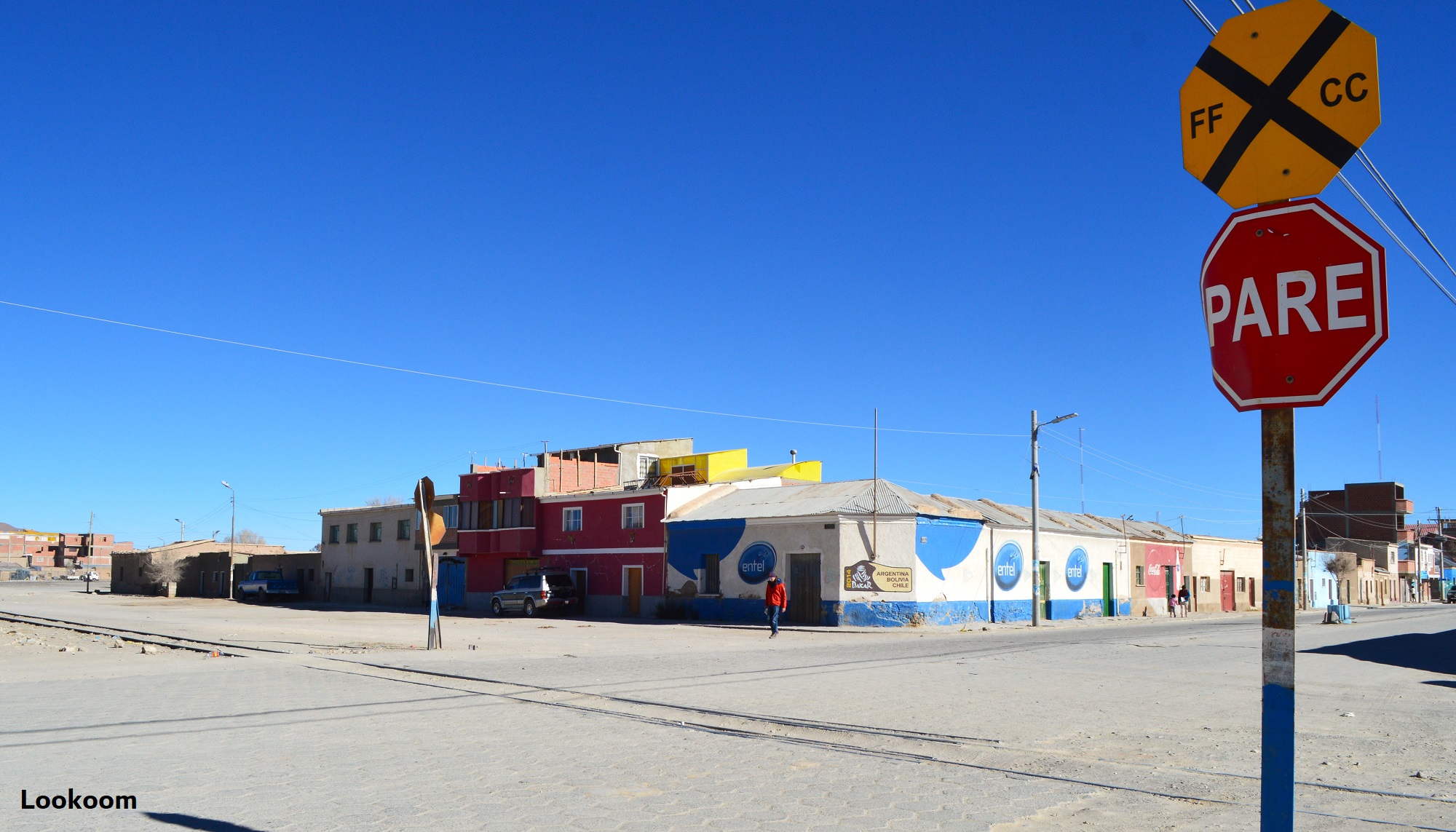(continuer en français) – Last updated: November 3, 2023
In the Bolivian Andes, Potosi exists because there is the Cerro Rico, the Rich Mountain. It dominates the city from its desolate cone, hiding the wealth it contains. The mines of silver, but also tin and zinc explain the existence of a city at more than 13.400 feet, 4.000 meters, of altitude.
The Spaniards did not take long to reach Potosi after the discovery of America in 1492, as early as 1545 the city was founded. Enormous quantities of silver were produced for decades, mainly conveyed to Spain. The city grew to around 200,000 people, more than Madrid, Paris or London at the time. From the 19th century onwards, silver became rarer, tin and zinc took over to some extent and then declined towards the end of the 20th century. The city struggled to adapt to this change in fortune.
The Casa Real de la Moneda was in charge of transforming the silver extracted from the mines into coins. Potosi, Lima and Mexico City were the three main minting locations in America during the Spanish Empire.
In the centre of the old colonial city, the Plaza 10 de Noviembre, the date of a revolt against the Spanish, is surrounded by the headquarters of the civil and religious authorities, it is where everything happens. The inhabitants come here to walk around, spending time on the benches, sunbathing or chatting.
The slightest pretext can mobilise the troupe of traditional dancers. To the sound of repetitive music, women and men form two groups that gradually move closer together as they waddle, but the parade ends before they reach each other.
Beyond the Plaza 10 de Noviembre, the streets are narrow and rarely for pedestrians. Streets are often sloping, the traffic is dusty and congested with old vehicles.
The old colonial houses seem to have difficulty weathering the passage of time; their appearance often looks to be deteriorated. They have suffered from many years of neglect by the authorities, who unfortunately were not very concerned about valorising their colonial past for political reasons.
The wooden balcony is often the main decorative element of the facade. Of a more fragile material, they are the first to show signs of decay.
The Casa de las Recogidas, built by the Franciscans in the 18th century, is one of the most beautiful houses in Potosi. It has a baroque façade with three heavily decorated portals, the profusion of motifs is also enhanced by the contrast between white and blue.
The churches are numerous, each religious order having sought to collect a share of the wealth generated by the Potosi mines. Sponsored by wealthy donors, the churches reproduce the styles fashionable in Spain.
In the heart of the historic old town, the Church of San Francisco with its high square bell tower was the first church built in Potosi, begun as early as 1547.
The Santo Domingo church dates from the 17th century, it was used as a prison in the 19th century and until 2000. The church and its former convent have recently been restored.
The Santa Teresa convent dates from the end of the 17th century, and was intended to receive nuns from the upper class. Richly endowed by their families, they contributed to the financial wealth of the convent, allowing for an abundant and beautiful decoration. The convent has now been transformed into a museum specialising in sacred art.
The most remarkable religious façade is certainly the church of San Lorenzo de Carangas, whose baroque portal was exuberantly carved by indigenous artists in the 18th century. They mixed Catholic motifs with what survived from the ancient religions, such as the recurring representations of mermaids.
San Benito is another church designed to receive the indigenous faithful. It was built between 1711 and 1758 outside the walls of the Spanish city. The present historic centre was indeed walled and reserved for the Spanish.
Dominated by the Cerro Rico, the working-class district of San Benito is located outside the historic centre, many houses still have only rudimentary comfort.
Social inequalities continue to leave a strong mark on Bolivian society. They begin in childhood, separating those going to school in their clean uniforms from other children hanging out in the streets and doing odd jobs.
Across Bolivia, Zebras are positioned at zebra crossings to help schoolchildren cross safely, they also assist other passers-by. The signs are sometimes open to interpretation.
Part of the city market is held in the open air. This seems to be a distraction for some of the inhabitants; they watch the trading while sitting on the benches talking to their fellow people.
In addition to the official shops and markets, street vendors can be found all over the city offering their modest wares, often related to food.
Potosi is now trying to find a new vocation with tourism. Located between Sucre and Uyuni, it is an interesting stopover on a trip to the south of Bolivia, based on its old colonial quarter and the curiosity sparked by t
To be informed of upcoming articles, register here (it’s free!).
Articles about Bolivia:
…
La Paz: Top 10
Strangely enough, La Paz is the administrative capital of Bolivia, where the national government has settled, while Sucre remains the official capital designated by the Constitution.
Sucre : Top 10
Since the civil war at the end of the 19th century political power has been based in La Paz, preserving Sucre from the excesses of change.
Sucre, Casa de la Libertad
It was there that on August 6, 1825 Independence and the Republic were proclaimed.
Potosi
The mines of silver, but also tin and zinc explain the existence of a city at more than 13.400 feet, 4.000 meters, of altitude.
Silver mines of Potosi
A visit to the silver mines is a must during a stay in Potosi.
The Tiwanaku mysteries
The site highlights a pre-Inca culture that reached a high level of organisation, qualities that the Incas would inherit and perfect.
The streets of Uyuni
At an altitude of over 11,800 feet, 3,600 metres, Uyuni attracts many visitors to Bolivia, not for the town itself, but as a starting point to travel the Salar de Uyuni and the South Lipez region.
Salar de Uyuni
A geological curiosity, the Salar of Uyuni is a tourist attraction that draws many travellers. It is located at an altitude of 11,800 feet, 3,600 metres, in southern Bolivia.
The Jesuit Missions of Chiquitanía
Founded by the Jesuits in the 17th and 18th centuries, these missions were established to evangelize the Chiquito people.
To be informed of upcoming articles, register here (it’s free!).

























































Beautiful
LikeLiked by 1 person
It is both beautiful and interesting.
LikeLiked by 1 person
🙂
LikeLiked by 1 person
Love to return..only crossed over for the day from Puno.
LikeLiked by 1 person
Bolivia is a country that I found very authentic, despite the number of visitors. Several regions deserve attention, La Paz, Sucre, Potosi and Uyuni but also the Jesuit missions in Chiquitania.
LikeLike
What a beautiful post, Lookoom. I look forward to visiting Potosi someday thanks to your introduction. Love the close up of rooftops and buildings in San Benito, as well as the detail of San Lorenzo de Carangas. Wonderful photos!
LikeLiked by 1 person
Thank you for your comment. I have always enjoyed my travels in Bolivia, it is a country that has remained very authentic, cheap but with good infrastructures due to the number of travellers.
LikeLike
My brother feels the same — has a deep love for Bolivia from time spent there.
LikeLiked by 1 person
Thanks for confirming. So it’s not just me 🙂
LikeLiked by 1 person
I’ve always regretted not visiting Peru when I was younger and could cope with rough travel and now I may have left it too late. Two years gone from one’s life with the dreaded Covid (I’m presuming next year to be a write-off as well) leaves me wanting to return to familiar and loved places in Europe – especially Italy. I just want to get back there and be enveloped in the warmth of that country.
LikeLiked by 1 person
I understand your choice. Although travel to South America has become easier, the distances and connections between countries are not equivalent to those in Europe. Whatever the personal conditions, we have to accept the idea that we can’ t see everything, nor go everywhere. What is important, however, is to keep feeding our curiosity with interesting places, and Europe offers many possibilities.
LikeLiked by 1 person
Sounds like Potosi has such a rich and interesting history. It’s hard to imagine that this town used to have more people than Madrid, Paris or London. I would love to visit Bolivia someday.
LikeLiked by 1 person
Bolivia has a lot to offer. Even though the country is less developed than its neighbours, the tourist sector works well, with competent professionals and efficient infrastructures. It is therefore both exotic and interesting given the historical background of the country.
LikeLiked by 1 person
Interesting that people can live at this altitude, let alone thrive. Thanks for sharing. Allan
LikeLiked by 1 person
You raise an important point. The altitude is sometimes difficult for visitors to bear. The inhabitants are of course accustomed to it, but certain pathologies are unfortunately more frequent, notably those related to the heart.
LikeLiked by 1 person
Makes me realise I didn’t explore or photograph the city thoroughly at all. It was all about the silver mine. Beautiful shots you’ve got here
LikeLiked by 1 person
Thanks Andy. I know that it is difficult to do everything when you have little time. The mines are certainly the most distinctive feature of Potosi, so it’s not a bad choice to put them first.
LikeLike
A great tour through Potosi, I have not realized it is at a such high altitude, even higher than La Paz.
LikeLiked by 1 person
You’re right, it’s a bit higher. I was lucky enough I spent several days in Sucre just before, so I didn’t feel the effect too much.
LikeLiked by 1 person
This is fascinating and the photos are beautiful! Wow I definitely want to experience this beautiful land! ❤️
LikeLiked by 1 person
Bolivia has a lot to offer to visitors, from Jesuit missions to historic Andean cities and the landscapes around them. I am glad that my photos give you a good impression of that insteresting country.
LikeLike